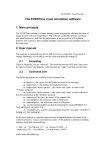Download ZR-03-38
Transcript
Konrad-Zuse-Zentrum
für Informationstechnik Berlin
Takustraße 7
D-14195 Berlin-Dahlem
Germany
S VEN B URGER , ROLAND K LOSE , ACHIM S CH ÄDLE , AND
L IN Z SCHIEDRICH
HelmPole - A finite element solver for scattering
problems on unbounded domains:
Implementation based on PML
ZIB-Report 03-38 (November 2003)
Abstract
The solution of scattering problems described by the Helmholtz equation on unbounded domains is of importance for a wide variety of applications, for example
in electromagnetics and acoustics. An implementation of a solver for scattering
problems based on the programming language Matlab is introduced. The solver
relies on the finite-element-method and on the perfectly-matched-layer-method,
which allows for the simulation of scattering problems on complex geometries
surrounded by inhomogeneous exterior domains. This report gives a number of
detailed examples and can be understood as a user manual to the freely accessible
code of the solver HelmPole.
Contents
1 Introduction
3
2 Installation
5
3 Quick Start
3.1 Getting started . . . . . . . . . . . . . . . . . . . . . . . . . . . .
3.2 The problem description file: Waveguide.m . . . . . . . . . . . . .
3.3 Running the program . . . . . . . . . . . . . . . . . . . . . . . . .
6
7
7
11
4 Examples
4.1 Waveguide - revisited . . . . . . . . . . .
4.2 Resonant coupling of optical waveguides
4.3 Acoustic scattering . . . . . . . . . . . .
4.4 Gauß beam . . . . . . . . . . . . . . . .
.
.
.
.
.
.
.
.
.
.
.
.
.
.
.
.
.
.
.
.
.
.
.
.
.
.
.
.
.
.
.
.
.
.
.
.
.
.
.
.
.
.
.
.
.
.
.
.
.
.
.
.
.
.
.
.
13
13
15
19
20
5 Function References
5.1 The main program: MAIN . . . . . . . . .
5.2 User interface: PROBLEMNAME . . . . . . .
5.3 Geometry description: COARSEGRID . . .
5.4 Material description: MATERIALFILE . . .
5.5 Incident wave file: INCWAVE . . . . . . .
5.6 Discretization of the exterior: MAKERAYS
5.7 Dirichlet data . . . . . . . . . . . . . . .
5.8 Exact Solution . . . . . . . . . . . . . .
.
.
.
.
.
.
.
.
.
.
.
.
.
.
.
.
.
.
.
.
.
.
.
.
.
.
.
.
.
.
.
.
.
.
.
.
.
.
.
.
.
.
.
.
.
.
.
.
.
.
.
.
.
.
.
.
.
.
.
.
.
.
.
.
.
.
.
.
.
.
.
.
.
.
.
.
.
.
.
.
.
.
.
.
.
.
.
.
.
.
.
.
.
.
.
.
.
.
.
.
.
.
.
.
.
.
.
.
.
.
.
.
23
23
25
29
31
32
33
36
37
6 Theory
6.1 Helmholtz equation . . . . . . . . . . . . . . . . . . . . . . . . . .
6.2 The PML method in 1D . . . . . . . . . . . . . . . . . . . . . . .
6.3 Discretization of the exterior . . . . . . . . . . . . . . . . . . . . .
38
38
39
40
7 Grid Generation
7.1 Conversion interface: TRIANGLE2MAT . . . . . . . . . . . . . .
42
42
8 License and Copyright
44
2
Chapter 1
Introduction
HelmPole is a Matlab-program for the solution of scattering problems on unbounded domains in two dimensions, written by L. Zschiedrich [11]. The algorithm is based on the finite-element-method and the perfectly-matched-layermethod (PML method) originally introduced by Berénger, cf. [1]. In contrast
to the interpretation of the PML, as an absorbing material, given by Berénger,
the interpretation here is a complex continuation of the solution in the exterior
domain. This ansatz can be found for example in the papers by Lassas and Somersalo [7, 6] and Collino and Monk [2] for homogenous exterior. Based on the
work of F. Schmidt [8] HelmPole however allows for certain types of inhomogeneous exterior domains, including waveguide structures. A detailed description
of the implementation can be found in [9]. Convergence issues of the PML are
discussed in [4].
This manual gives a detailed description of HelmPole’s user-interface, which
allows to adapt geometries and material properties as well as the characteristics of
the incoming wave. The two main applications of HelmPole are electromagnetic
and acoustic scattering.
Typical electromagnetic scattering problems are modeled by Maxwell’s equations
∇ · B = 0,
∇×E =−
∇ · D = ρ,
∂B
,
∂t
∇×H =j+
(1.1)
∂D
,
∂t
(1.2)
with permeability µ = 1, vanishing charge density ρ, vanishing electric current
density j and a spatial dependent relative permittivity (x). Assuming a harmonic time-dependency, equations (1.2) take the form
∇ × E(x) = −µ0 iωH(x),
∇ × H(x) = 0 (x)iωE(x).
3
(1.3)
Decoupling these equations yields the photonic wave equations
1
ω2
∇×
∇ × H(x) = 2 H(x),
(x)
c
ω2
∇ × (∇ × E(x)) = (x) 2 E(x).
c
(1.4)
(1.5)
HelmPole assumes problems, homogeneous in z-direction. For light propagating
only in xy-direction, it is possible to separate modes in two different polarizations.
In the case of TE-polarization the H-field takes the form (0, 0, Hz ), and the
photonic wave equation (1.4) simplifies to
ω2
1
∇Hz (x, y) + 2 Hz (x, y) = 0.
(1.6)
∇·
(x, y)
c
In the case of TM-polarization the E-field takes the form (0, 0, Ez ), and the
photonic wave equation (1.5) simplifies to
4Ez (x, y) +
ω2
(x, y)Ez (x, y) = 0.
c2
(1.7)
For an introduction to acoustic scattering we refer to [5], where a derivation
of the Helmholtz equation (1.8) from linearized equations for compressible fluids
may be found. The stationary pressure p in a compressible fluid is given by
∆p + k 2 p = 0
with the wavenumber
(1.8)
ω
,
(1.9)
c
where ω is the circular frequency of the wave and c is the speed of sound.
The plan of this manual is as follows. Chapter 2 describes the installation
of the Matlab package HelmPole.tar. Chapter 3 guides the user through a test
run of HelmPole with the parameters of the ’wave-guide’-example. In Chapter 4
several further examples give the user a feeling for the different problems which
can be approached by HelmPole. Chapter 5 provides a detailed explanation of all
variables which can be modified by the user. Chapter 6 gives a short introduction
to the theory of the PML method and describes the coordinate system used to
discretize the exterior. Chapter 7 shortly presents a conversion interface to the
triangular grid generation tool triangle by J. Shewchuk.
k :=
4
Chapter 2
Installation
To install HelmPole, extract the tarred file HelmPole.tar.gz by typing:
tar -xzvf HelmPole.tar.gz
This creates a directory /HelmPole/, containing the subdirectories /examples/,
/fun/, /geo/, /trianglefiles/, the function startup.m, and the file main.dll.
The subdirectory /examples/ contains examples of problem description files
(see chapter 5.2). User defined functions for the description of materials, boundaries, incoming fields, etc. are located in the subdirectory /fun/. The subdirectory /geo/ contains geometry description files (see Section 5.3), which have
been created using the files located in the subdirectory /trianglefiles/ (see
chapter 7).
To run HelmPole, you need the programming language Matlab
(http://www.mathworks.com). For applications with complex, user-defined
geometries, we recommend the triangulation tool triangle by J. Shewchuk,
freely accessible under http://www-2.cs.cmu.edu/~ quake/triangle.html
(see chapter 7).
To check if your version is working, go through the example described in Chapter 3.
5
Chapter 3
Quick Start
In this chapter we go through a sample session of HelmPole step by step. This
should give a basic idea of the program and its possibilities. A more complete
description of the supported features is given in Chapter 5. In Chapter 4, a
detailed description of various further examples is given.
In our example we simulate the propagation of light in an infinite straight
waveguide in space R2 . To obtain a bounded computational domain we introduce
an artificial, so called ’outer’ boundary. The computational domain we get this
way in the example is a square region with a straight waveguide of high refractive
index material and a low index background (see Figure 3.1). The light field
reaching the computational domain from the exterior from left is the lowest mode
of the waveguide.
6
6
4
4
2
2
0
0
−2
−2
−4
−4
−6
−6
−4
−2
0
2
4
−6
−6
6
−4
−2
0
2
4
Figure 3.1: Geometry and material distribution of the problem Waveguide.m.
6
6
3.1
Getting started
Start Matlab and change to your HelmPole directory. Within this directory you
locate the folders
/examples/, /fun/, /geo/, /trianglefiles/,
the function
startup.m,
and the file
main.dll.
Set the necessary environment variables by typing:
startup
Else you can start Matlab from the directory HelmPole. Matlab will then
automatically set the necessary environment variables by examining the file
startup.m
3.2
The problem description file: Waveguide.m
Start an editor and load the file Waveguide.m which is located in the directory
/examples/. This file is the interface in which the user can choose from the
different features of the program and set variables.
The file looks as follows:
function [problem, AlgPara] = waveguide(Para)
;
%% template for problem description file
%% for data structure and syntax read README
%% ------ geometry, material,sources and incoming waves ----k0 = 1;
TM = 1;
CoarseGrid
= ’w’;
Material.File
Material.Para.k
Material.Para.n1
Material.Para.n2
=
=
=
=
’Waveguide_material’;
k0;
1.45; % relativ refraction index of substrate material
6.6; % relativ refraction index of waveguide material
IncWave.File
= ’Waveguide_income’;
IncWave.Para
= Material.Para;
IncWave.Para.TM = TM;
IncWave.Para.WaveGuidePos = [ -6 -6 ; ...
-0.2 0.2];
Exterior.Material.File
= ’Waveguide_material’;
7
Exterior.Material.Para
= Material.Para;
Exterior.Ray.File
Exterior.Ray.Para
= ’makeRays_normal’;
= [];
Exact.File = ’Waveguide_exact’;
Exact.Para = IncWave.Para;
Exact.Para.lambda = 5.04973;
%% -------------- algorithmic parameters ------------------Int.UniRefine = 0;
Int.PreRefine = 0;
Int.PpW = 5;
FEM.Type = ’quadratic’;
TBC.Method = ’PML’;
TBC.PML.k = k0;
TBC.PML.xi
= [0 : 2^3].^3/2^9;
TBC.PML.DampFun = ’pml_jump’;
TBC.PML.d
= 1;
%% -------------------------- Plots -------------------------Plots.Triangulation = 1;
Plots.Material = 1;
Plots.Solution.Real = 1;
Plots.Solution.Imag = 0;
Plots.Solution.Abs = 1;
Plots.Solution.Log = 0;
Plots.Solution.Contour = 0;
Plots.ExactSolution.Real = 1;
Plots.ExactSolution.Imag = 0;
Plots.ExactSolution.Abs = 1;
Plots.ExactSolution.Log = 0;
Plots.ExactSolution.Contour = 0;
%% ------------ Do not edit beyond this line !! ------------...
8
First, geometry, material, sources, and incoming waves are set: In the first
lines the wavenumber k0 is set, and the searched light field is chosen to be TM
polarized. Then the string ’w’, the name of the binary .mat file w.mat is specified as the name of the file with the geometry description of the computational
domain. In this case our computational domain is a square, with a horizontal
waveguide. For details of the geometry description see Section 5.3. The file w.mat
is located in the folder /geo/ and has been created previously by a triangulation
tool (see Chapter 7).
Next, different refractive indices are attributed to different regions
in the geometry of the interior domain by setting Material.File =
’Waveguide material’, and the above defined wavenumber is attributed to
the interior domain. For the syntax of the Material.File see Section 5.4.
Material.Para is a structure that is passed to the Material.File. The file
Waveguide material.m is located in the directory /fun/.
1.6
1.4
1.2
1
0.8
0.6
0.4
0.2
0
−6
−4
−2
0
2
4
6
Figure 3.2: Amplitude distribution of the incoming wave along the left part of
the outer boundary for the problem Waveguide.m.
With IncWave.File = ’Waveguide income’; the incident wave is specified.
In the following lines parameters for the incoming field are set. These are the
material parameters plus some additional parameters. The parameters are used
by the file Waveguide income.m in /fun/ to calculate the Dirichlet data and the
Neumann data at the left boundary of the computational domain. See Section 5.5
for a detailed description of the syntax of IncWave.File.
Then the exterior is specified: The exterior is divided into segments between rays starting at the computational domain and going outwards to infinity.
Exterior.Material.File describes the refractive indices in the exterior. It has
the same syntax as Material.File and in this case it is the same file. Thus we
have to pass the parameters Material.Para to Exterior.Material.Para.
The Exterior.Ray.File specifies the discretization of the exterior. By specifying makeRays normal, normal rays to the boundary are chosen. At corners,
the normal is defined to be the mean of the two normal vectors to the adjacent
9
Real part
Absolute value
1.5
6
6
1.4
4
1.2
1
1
4
2
0.5
2
0
0
0
−2
−0.5
0.8
0.6
−2
0.4
−4
−4
−1
−6
0.2
−6
−1.5
−6
−4
−2
0
2
4
6
−6
−4
−2
0
2
4
6
Figure 3.3: Real part and absolute value of the solution of the problem Waveguide.m.
edges. How to define rays in general is described in Section 5.6. In this case
the structure Exterior.Ray.Para is empty, however, it cannot be omitted. The
use of makeRays normal should be limited to smooth computational domains.
In the present example it gives a bad discretization of the exterior, because the
outgoing segments at corners of the computational domain cannot be improved
by choosing a finer computational grid in the interior. In the example described
in Section 4.1 we will explain how to obtain “good” rays.
Exact.File is the name of the .m file located in /fun/ that computes the
exact solution for a given set of points. This function is supplied to the program
in order to facilitate the study of the convergence of the discrete solution towards
the exact solution. Parameters are passed to Exact.File with the structure
Exact.Para. Except for the parameter Para.la these are the same as for the
incoming wave. In our example Para.la is the first eigenmode of the waveguide.
This eigenmode is calculated in IncWave.File .
Then algorithmic parameters follow: With Int.UniRefine = 0; we choose
the number of uniform refinement steps of the coarse grid. Also, a pre-refinement
that locally equalizes the number of discretization points per wavelength is omitted: Int.PreRefine = 0;. Instead, by setting Int.PpW = 5 we refine the coarse
grid locally such that there are at least 5 points per wavelength.
By FEM.Type = ’quadratic’; , quadratic finite elements are chosen.
With TBC.Method = ’PML’; the type of transparent boundary conditions is
chosen to be the method of perfectly matched layers. TBC.PML.k = k0 sets the
wavenumber in the exterior domain. The discretization of each segment in the
exterior domain is characterized by TBC.PML.xi. This is a vector giving the discretization of the variable ξ in (6.5). TBC.PML.DampFun = ’pml jump’; defines
the damping function for the PML “ pml jump = γ ” cf. (6.6) and TBC.PML.d
10
= 1; sets the damping factor σ = 1 in (6.6). More details on how to set the
algorithmic parameters are provided in Section 5.2. For a brief introduction to
PML see Chapter 6.
In the following lines different features are chosen to be plotted during the
program execution. Contour lines can only be plotted if the Matlab PDE toolbox
is available. Some more lines follow in the problem description file which should
not edited by the user and which are not described here.
Real part
Absolute value
1.5
6
1
4
6
1.4
4
1.2
1
2
0.5
2
0
0
0
−2
−0.5
0.8
0.6
−2
0.4
−4
−1
−6
−4
0.2
−6
−1.5
−6
−4
−2
0
2
4
6
−6
−4
−2
0
2
4
6
Figure 3.4: Real part and absolute value of the exact solution to problem Waveguide.m.
3.3
Running the program
Now we are ready to start the program by typing
main(’Waveguide’)
at the matlab prompt.
During the run, a number of windows opens to show some information to
the user: The first opening window is shown in Fig. 3.1 The left part of this
figure shows the geometrical description of the problem. The interior domain is
triangulated, and the PML layer is divided into stripes, bordered by outgoing
arrows. Obviously the exterior domain is not well resolved at the corners by the
normal rays. A refinement of the interior domain would not improve that. The
right part of the picture shows the distribution of the material refractive index
in the interior domain.
The other opening windows show properties of the solution of the waveguide
problem: Figure 3.2 shows the distribution of the incoming light field along the
left boundary. Figure 3.3 shows the real part and the absolute value of the
11
Real part
Absolute value
6
0.15
6
4
0.1
4
2
0.05
2
0
0
0
0.18
0.16
0.14
0.12
0.1
0.08
−2
−0.05
−2
−4
−0.1
−4
−6
−0.15
−6
−6
−4
−2
0
2
4
6
−6
0.06
0.04
0.02
−4
−2
0
2
4
6
Figure 3.5: Real part and absolute value of the error of the solution (Fig. 3.3) of
the problem Waveguide.m.
discrete solution. Figure 3.4 shows the exact solution of the problem, obtained
semi-analytically, and Figure 3.5 shows the real part and the absolute value of
the error of the discrete solution.
Additionally, Figure 3.5 shows the real part and the absolute value of the
error of a more accurate solution, obtained from a run of Waveguide.m, using
Int.UniRefine = 1 and Int.PpW = 10.
Real part
Absolute value
0.02
6
0.02
6
0.015
4
0.018
4
0.016
0.01
2
0.005
0
0.012
0
0
−0.005
−2
0.014
2
0.01
0.008
−2
0.006
−0.01
−4
−0.015
−6
−6
−4
−2
0
2
4
6
−4
0.004
0.002
−6
−6
−4
−2
0
2
4
6
Figure 3.6: Real part and absolute value of the error of the problem Waveguide.m
obtained with Int.UniRefine = 1 and Int.PpW = 10.
On the command line some information is given on the progress of the main
driver. If the exact solution is provided relative errors are printed.
12
Chapter 4
Examples
In this chapter we discuss some more examples. Section 4.1 shows how to describe waveguides in different geometries and how to obtain rays that give a
better discretization of the exterior. Section 4.2 deals with the resonant coupling
of optical waveguides via rectangular microcavities, with an example originally
discussed in [3]. In Section 4.3 an example from acoustic scattering is discussed.
We present two ways how to calculate the field scattered by a “soft” object.
Section 4.4 discusses a Gauß light beam incident on the computational domain.
4.1
Waveguide - revisited
The example Waveguide2a is run by typing the command
main(’Waveguide2a’)
at the Matlab prompt.
In this case the computational domain is a rectangle given by [0 ; 1] × [−2 ; 2]
with an infinite waveguide directed along an axis given by y = 2x − 1, cf. Figure 4.1.
Besides the different geometry of the problem, the main differences to the
example Waveguide are the way how to describe the incident wave and the way
how to define the rays for the discretization of the exterior. This is done by
setting:
IncWave.File
= ’Waveguide_income2’;
IncWave.Para
= Material.Para;
IncWave.Para.a
= -2;
IncWave.Para.b
= 1;
IncWave.Para.c
= 1;
IncWave.Para.d
= 0.4*sqrt(1/5);
IncWave.Para.Plot = 1;
and
13
Exterior.Ray.File = ’makeRays_waveguide’;
Exterior.Ray.Para.vertices = [ 0 2;
1 2;
1 -2;
0 -2];
Exterior.Ray.Para.vray = [-1 2;
1 2;
1 -2;
-1 -2];
Exterior.Ray.Para.Waveguide = [0 -1.5 atan2(2,1) ;
0 -0.5 atan2(2,1) ;
1 1.5 atan2(2,1) ;
1 0.5 atan2(2,1)];
The incident wave is described using the function Waveguide income2 in subdirectory /fun/. This function can be used to describe the incident field for many
different geometries. The parameters passed to this function are the wavenumber Para.k, the parameters Para.a, Para.b, and Para.c describing the axis
of the waveguide ax + by + c = 0. The thickness of the waveguide is set by
Para.d, see Fig 4.1. Para.WaveGuideIndexin and Para.WaveGuideIndexout
are the relative refractive indices of the waveguide material and of the substrate
material, respectively. Waveguide income2 calculates the incident wave at the
“left” boundary of the computational domain which is the lowest mode of this
waveguide. As we are calculating a guided wave, we can associate a direction
with this wave. This wave is said to travel from “left” to “right”. If we take the
normal to the waveguide through the middle of the waveguide, this normal cuts
the boundary of the computational domain in two pieces. The one that lies left
to the normal is the “left” boundary of the computational domain. Prescribing
the incident field only on the left boundary of the computational domain and
setting is to zero for the right part of the boundary an error is introduced by
the jump in the boundary condition. This error becomes visible if you chance
the Int.PpW in Waveguide2a to 10 and it is prominent if you choose Int.PpW
equal to 20. Choosing 20 instead of 10 points per wave length the maximum
error decreases only negligible. Note that we discretize the PML according to
the interior to see this behavior. The rays for the discretization of the exterior
are calculated using the function makerays waveguide. The rays have to be chosen such that the refractive index is constant in each segment of the exterior,
i.e., between each pair of rays. Therefore the rays have to be adjusted to the
waveguide in the exterior. In addition, the rays have to form an admissible discretization of the exterior, see Section 5.6 and Chapter 6. The parameters passed
to makerays waveguide are Para.vertices, Para.vray and Para.Waveguide.
Para.vertices are the x, y coordinates of the polygonal computational domain
in clockwise order. Para.vray are x, y coordinates of the rays ~v prescribed at the
14
~v
~v
w
~
ax + by + c = 0
α
w
~
ν
d
PSfrag replacements
w
~
ν
α
w
~
~v
~v
Figure 4.1: Geometry of waveguide in example Waveguide2a
edges, which have to be chosen to be admissible. Para.vray may be empty, in
which case the rays are chosen to be the mean of the normal vectors of the two
adjacent faces at each vertex. If we would not specify Para.vray in this example
the rays at the vertices would intersect with the waveguide, and we could not
obtain a valid discretization of the exterior. Para.Waveguide gives the position
and direction of the waveguide. Each row of Para.Waveguide specifies one ray,
by giving the x and y coordinate of the root point of the ray and the angle α
between the ray vector w
~ and the normal vector ν of the face of the polygon.
The geometry in example Waveguide2a seems to be very disadvantageous.
The reason for that is not clear. Maybe the acute angle in the finite elements in
the PML causes this problem.
Other examples with waveguides are Waveguide2 and Waveguide2b.
4.2
Resonant coupling of optical waveguides
This example deals with the resonant coupling of optical waveguides via a rectangular microcavity (see Ref. [3]). To run the simulation invoke the script
mcr2analyser.m which is located in the folder /fun/. In the problem description
file mcr2 the number of points per wavelength is set to 15, to obtain accurate
results. However, this means that there are about 100.000 unknows in the linear
15
system.
The coputational domain of the problem is shown in Figure 4.2. Two horizontal infinite straight waveguides are coupled by a rectangular microcavity. The
outer boundary is again a rectangle. At port PA we prescribe the incident wave
traveling in the waveguide. At ports PA , PB , PC and PD the response of the
microcavity is measured. We want to plot the power flux at the ports depending
on the wavenumber, respectively wavelength of the incoming wave.
PD
PC
w
PSfrag replacements
g
y
W
x
L
PA
PB
x=a
x = −a
Figure 4.2: Resonance coupler
In this example we choose the parameters W = L = 1.451, g = 0.4 and
w = 0.073. The waveguide material and the cavity have a relative refractive
index of 3.4, and the substrate has relative refractive index of 1.45.
The problem description file is mcr2.m, located in /examples/. Let’s have a
look at it first. Using the argument Para we can pass different wavenumbers to
the problem description file. Additionally, the first eigenmode of the waveguide
and the relative refractive indices of the waveguide material and the substrate
are passed to the problem description file. The function mcr2 income calculates
the incident wave at port A. It is important that no further, “outgoing” fields are
given anywhere. Using the function makerays waveguide rays for the discretization of the exterior are calculated. See Section 4.1 for a detailed description of
that function.
The script mcr2analyser.m in /examples/ is essentially a loop over different
wavelengths. In the first part the first eigenmode of the waveguide is calculated.
As the two waveguides are of the same material and width w this is done once.
With a call to main the problem is solved. The rest of the script analyses the
16
scattered field and calculates the power flux along the waveguides at each port.
The result is shown in Figure 4.3 .
Let’s have a closer look at the physics of this problem. We start with
some elementary considerations about guided waves for the Helmholtz equation
∆u (x, y)+k 2 (y) u (x, y) = 0 in a two dimensional space. Here the local wavenumber k does not depend on x. Recall that the electrical fields z-component of
a TM-polarized electromagnetic wave satisfies a scalar Helmholtz equation. A
guided wave is a field distribution which varies harmonically in x-direction,
ug (x, y) = ψ (y) eikx x .
Since ug satisfies the Helmholtz equation we conclude that
∂yy ψ (y) + k 2 (y) ψ (y) = kx2 ψ (y) .
Hence ψ is an eigenfunction to the operator ∂yy + k 2 (y). Using results from
spectral theory we decompose a function w (y) as
X
cl ψl (y) ,
w (y) =
l
where the ψl are eigenfunctionsRof the operator ∂yy + k 2 (y). The coefficients cl
∞
are given by the integral cl = −∞ ψl∗ (y)w (y) dy. Here our notation is formal
since for the continuous part of the spectrum the sum must be replaced by an
integral. The eigenfunctions ψl are orthogonal to each other,
Z ∞
ψl∗ ψl0 dy = δl,l0 .
(4.1)
−∞
For any splitting cl = cl,− + cl,+ the function
X
X
u (x, y) =
cl,− ψl (y) e−ikx,l x +
cl,+ ψl (y) e+ikx,l x
l
l
is a solution to the Helmholtz equation. The left sum corresponds to left traveling
waves and the right sum to right traveling waves. To compute the splitting assume
that also
R ∞v (y) = ∂x u (x, y) is given for x = 0. Using the orthogonality relation
we get −∞ ψl∗ v (y) dy = −ikx (cl,+ − cl,− ). Hence given any solution u to the
Helmholtz equation ∆u (x, y) + k 2 (y) u (x, y) = 0 we are able to compute the
above splitting by the two formulas
Z ∞
cl,− + cl,+ =
ψl∗ u (0, y) dy,
Z−∞
∞
−ikx (cl,+ − cl,− ) =
ψl∗ ∂x u (0, y) dy.
−∞
17
We now consider the case of a TM-polarized time-harmonic electromagnetic wave
in a waveguide. The electrical field is given as
0
0
E (x, y) =
Ez (x, y)
The time average power flux along the waveguide direction is given by the xcomponent of the Poynting vector
1
S = < (E × H ∗ ) .
2
√
Making use of H = −iγ · curl E with γ = µ/k we get
Sx =
γ
< (iEz ∂x Ez∗ ) .
2
To compute the total power flux Px in x-direction we integrate this expression
over y. Splitting Ez as above,
X
X
cl,+ ψl (y) e+ikx,l x
cl,− ψl (y) e−ikx,l x +
Ez =
l
l
and using the orthogonality relation (4.1) we end up with
X
X
Px =
kx,l · cl,− −
kx,l · cl,+ .
|l
{z
Px,−
}
|l
{z
Px ,+
}
Hence for each l in the sum above Px,l,+ = kx,l · cl,+ is that part of the left
going power flux Px,+ which is transported by the lth guided mode. In the
example above we want to compute the coupling of the scattered field with the
fundamental modes of the waveguides. At each port the scattered field excites
the fundamental mode of the waveguides. Let us restrict the analysis to Port C.
Assume that the solution field Ez (x, y) is given at every point (x, y) ∈ R2 . Since
there is no incoming wave from the right (c0,− = 0) the overlap integral
Z ∞
PC =
Ez (a, y) ψ0 (y) dy.
(4.2)
−∞
is equal to Px,0,+ . The simulation only yields the total field Ez within the computational domain. But since the fundamental mode ψ0 is evanescent outside the
waveguide we replace the infinite integral in (4.2) by an integration over the right
boundary of the computational domain. Figure 4.3 shows the power at the four
ports vs. the wavelength of the incoming eigenmode. For the parameters, see the
problem description file mcr2.m in /examples/.
18
1
0.9
0.8
lower left port
lower right port
upper right port
upper left port
frag replacements
ν
α
ax + by + c = 0
w
~
~v
d
power at port
0.7
0.6
0.5
0.4
0.3
0.2
0.1
0
1.54
1.542
1.544
1.546
1.548
1.55
1.552
wavelength
1.554
1.556
1.558
1.56
Figure 4.3: Normalized power at the four ports. A marker is plotted at every
10th point.
4.3
Acoustic scattering
This example treats acoustic scattering by soft infinite cylindrical obstacles in
R3 . Problems of this type can be reduced to two dimensional scattering from
closed curves.
Our computational domain Ω is a rectangular box with a hole. In order to
have the analytic solution at hand we take a circular hole. The boundary of Ω
naturally splits in two parts. One is the interior boundary Γint , the boundary of
the hole. The other is the exterior boundary Γext , where non-reflecting boundary
conditions have to be imposed.
For a derivation of the Helmholtz equation (4.3) as a mean to model acoustic
scattering see the introduction in the book by F. Ihlenburg [5].
∆p + k 2 p = 0 .
(4.3)
Here, p is the stationary wave and k is the wavenumber. The Helmholtz equation
has to be supplemented by boundary conditions at infinity, i.e. radiation conditions for the scattered field. If we want to bound the computational domain we
have to impose non-reflecting or absorbing boundary conditions at Γext . This can
formally be written using the linear operator DtN that given Dirichlet data on
the boundary Γ for the Helmholtz equation in the exterior returns the Neumann
data of the solution (∂ν p = DtN (p) on Γext ). One way to evaluate the operator
DtN is the PML method. Additionally we have a Dirichlet boundary condition
at Γint .
19
The total field p can be split into the known incident field pin and the scattered
field psc . All three are solutions of (4.3). At Γint we have that p = 0 = pin + psc
and hence pin = −psc .
Now there are two ways to formulate the problem:
• The first one is to derive an equation for the scattered field psc : psc has to
be a solution of the Helmholtz equation,
∆psc + k 2 psc = 0.
(4.4)
It has to fulfil the Dirichlet condition (soft scattering) psc = g on Γint , where
g = −pin |Γint , and it has to fulfil the Robin condition ∂ν psc = DtN (psc ) at
Γext .
• The other way is to derive an equation for the total field p: p has to satisfy
Equation (4.3). At Γint we have p = 0, and at the boundary Γext the
scattered field psc has to satisfy psc = p − pin ∂ν (p − pin ) = DtN (p − pin ) .
Two examples for the formulations are provided. Both model the scattering
of a plane sound wave by a soft circle. Try the examples Cylinder.m and
Cylinder2.m.
In Cylinder the incoming wave is set to zero, the Dirichlet values on the
interior boundary are set to the values of an incoming wave at these points. The
exact solution is calculated with a slightly modified formula taken from [5], cf.
p. 29-31, Example 2.4. A uniform refinement of the grid decreases the error
by a factor of 1/2 (linear finite elements) or 1/4 (quadratic finite elements),
respectively.
In Example Cylinder2 the incoming wave is specified by prescribing Dirichlet
and generalized Neumann data at the boundary of the computational domain
Γext . At the interior boundary homogenous Dirichlet data is set. In this case
for quadratic finite elements a uniform refinement of the grid decreases the error
only in the first refinement. The reason for this is that the circular geometry is
not resolved by successive uniform refinements of the coarse mesh. To decrease
the error one has to remesh the geometry.
4.4
Gauß beam
This examples calculates the field of a Gauß beam in a homogenous material. To
run it type (you will need about 1.5 GB memory to run this example):
Para.k = 4;
Para.matb = 3.5;
Para.matg = 3.5;
main(’gauss’,Para);
20
According to the book by Unger [10], p. 304, the field of a Gauß beam is
given by
λz
r2
πr 2
w0
exp − 2
− i kz +
− arctan
E(r, z) = E0
(4.5)
w(z)
w (z)
λR(z)
πw02
where λ = 2π/k is the wavelength,
R(z) = z +
and
w(z) =
s
w04 k 2
4z
w02 +
(4.6)
4z 2
.
w02 k 2
(4.7)
r
PSfrag replacements
z
2w0
2w
Figure 4.4: Gauß beam
The focus is at the point r = 0, z = 0. In the problem description file the
parameters for the Gauß beam are
IncWave.Para.k
IncWave.Para.a
IncWave.Para.b
IncWave.Para.c
IncWave.Para.w0
=
=
=
=
=
Material.Para.matb*k0;
1;
0.5;
0;
1;
This means in x, y coordinates the main axis is given by ax + by + c = 0 and the
focus is the cut of the main axis with the orthogonal axis bx − ay + c = 0. The
“exact” solution is the Gauß beam in the computational domain, which is only
an approximate solution to the Helmholtz equation. Thus the error is mainly due
to modeling a wave by a Gauß beam.
Typing
21
Para.k = 4;
Para.matb = 3.5;
Para.matg = 1;
main(’gauss’,Para);
calculates a Gauß beam as before incident on a photonic crystal with 3×7 holes on
a hexagonal grid. The error calculated for this setting of the material parameters
is meaningless.
22
Chapter 5
Function References
5.1
The main program: MAIN
Syntax
[PROBLEM,SOLUTION,ERROR,BOUNDARY] = MAIN(PROBLEMNAME)
[PROBLEM,SOLUTION,ERROR,BOUNDARY] = MAIN(PROBLEMNAME,PARA)
Argument
• PROBLEMNAME is a string, specifying the name of a MATLAB function
that describes the equation to be solved, the geometry, and the transparent boundary condition, cf. 5.2. Some example files with problem descriptions are included in /examples/. An example template is given in
/example/template.
• PARA is structure, it allows to pass any parameters to the main program.
Description
• [PROBLEM,SOLUTION,ERROR,BOUNDARY] = MAIN(PROBLEMNAME)
four structures:
returns
– PROBLEM describing the problem. The most important substructure is
PROBLEM.GEO with the fields P, the point data of the triangulation, T,
the triangle data of the triangulation and E the edge data. All three
are matrices as described in Section 5.3.
– SOLUTION a structure with the fields SOLUTION.U SOLUTION.UL and
SOLUTION.UG representing the solution. U is the solution-vector
in the interior domain and UL is the solution restricted to points
PROBLEM.GEO.P. If you use linear finite elements UL and U will be the
same. UG is the solution-vector of the complete system, including the
23
PML layer. If nn is the number of degrees of freedom in the interior domain UG(1:nn) equals to U. Setting the number of degrees of freedom
in the PML layer equal to npml, UG(nn+1:nn+npml) is the solution in
the PML layer. With the number of degrees of freedom on the outer
boundary, nbn, the generalized Neumann data of the scattered field
on the boundary is UG(nn+npml+1:nn+npml+nbn).
– ERROR If EXACT.FILE in the problem description file is empty, ERROR
is empty, too. Else, ERROR has four fields: a) ERROR.FIELD, a vector of
the same size as SOLUTION.U giving the pointwise error in the interior,
b) ERROR.L2, the relative l2 error, c) ERROR.LINF, the relative error
in the maximum norm and d) ERROR.REF the exact solution in points
PROBLEM.GEO.P.
– BOUNDARY a structure describing the boundary. We will not describe it
in detail here. BOUNDARY.P are xy coordinates of the boundayr points
of the triangulation. BOUNDARY.RAY are the rays used to discretize
the exterior. The transpose of BOUNDARY.PMP is the projection for
function values given on points of the triangulation, POEBLEM.GEO.P,
onto boundary points, BOUNDARY.P.
Example
[p,s,e,b]=main(’Waveguide’);
calls the example Waveguide, described in Section 3. There quadratic finite
elements are used. With
quiver(b.p(1,:),b.p(2,:),b.ray(1,:),b.ray(2,:))
you can plot the rays.
plot3(b.p(1,:),b.p(2,:),abs(b.PMP’*s.ul),’x’); hold on
plots the absolute value of the “linear” part of solution on the boundary.
24
5.2
User interface: PROBLEMNAME
The problem description file is located in the directory /HelmPole/. Examples
of problem description files can be found in /examples/. It is the the main user
interface where the parameters of the program run are set.
Syntax
[PROBLEM,ALGPARA] = PROBLEMNAME(PARA)
Argument
• PARA structure, this is the structure of parameters passed to MAIN.
Description
PROBLEMNAME returns two structures. PROBLEM describes the problem parameters
and ALGPARA describes the algorithmic parameters. The options for the different
parameter choices are listed below.
• k0: real, wavenumber
The wavenumber k0 specifies the wavenumber in equations (1.7) and (1.6).
• TM: integer, equation type
The TM-switch specifies which equation is to be solved:
TM=1: corresponds to equation (1.7) (TM polarization),
TM=0: corresponds to equation (1.6) (TE polarization).
• CoarseGrid: .mat coarse grid file (string), geometry description
The variable CoarseGrid is a string specifying the name of the .mat file
with the description of the geometry of the problem. The file is located in
the directory /geo/. The contents of this file is described in Section 5.3.
• Material: This specifies the nature of the materials in the interior computational domain.
– Material.File: .m file (string), local wavenumber
Material.File specifies the name of the corresponding file located in
the directory /fun/. The contents of this file is described in section 5.4.
– Material.Para: structure, parameters for Material.File. Material.Para may be empty.
• IncWave: This specifies the incident wave.
25
– IncWave.File: .m file (string), incident wave on the outer boundary
IncWave.File specifies the name of the file with the description of the
incident field. The file is located in the directory /fun/.
– IncWave.Para: structure, parameters for IncWave.File. IncWave.Para may be empty.
• Exterior: structure to describe the exterior.
– Exterior.Material.File: .m file (string), local wavenumber for the
exterior
Exterior.Material.File specifies the name of the file with the description of the material distribution in the exterior. The wavenumber
is constant in each segment described by the rays. This allows to
simulate waveguides.
– Exterior.Material.Para: structure, parameters for Exterior.Material.File, may be empty.
– Exterior.Ray.File: .m file (string), a function describing the rays of
the exterior discretization, see Section 5.6. There are three files already
provided in /fun/, namely makeRays normal.m, makeRays radial.m
and makeRays waveguide.m .
– Exterior.Ray.Para: structure, parameters passed to Exterior.Ray.File. The structure Exterior.Ray.Para may be empty.
• Dirichlet: structure, Dirichlet boundary data
This structure may be omitted if there are no interior edges, cf. Section 5.3.
– Dirichlet.file: .m file (string), Dirichlet data on interior boundaries. Dirichlet.file is the name of the file that calculates the
Dirichlet boundary values on the interior boundary.
– Dirichlet.Para: structure, parameters passed to Dirichlet.file,
may be empty.
• Exact.File: .m file (string), name of the file to calculate the exact solution
in the interior. The parameters passed to Exact.File are Exact.Para.
• Int.UniRefine: integer, number of uniform refinement steps of the coarse
grid (useful for convergence-studies).
• Int.PreRefine: integer, number of local refinement steps to obtain a ’balanced’ grid, i.e., the grid is refined where the local wavenumber is high
(obsolete, use Int.PpW instead). The algorithm picks the triangles with the
top 20 % of the largest triangles weighted by the local wavenumber.
26
• Int.PpW: real, local refinement to obtain at least Int.PpW discretization
points per wavelength locally.
• FEM.Type: string, finite element type
FEM.Type is ’linear’ for linear finite elements and ’quadratic’ for
quadratic finite elements.
• TBC.Method: string, specifies the method of the transparent boundary condition. The only method presently available in HelmPole is ’PML’ the
perfectly matched layer.
• TBC.PML: structure, parameters for the PML.
– TBC.PML.k: local wavenumber in each segment described by rays
– TBC.PML.xi: vector, discretization along the rays
TBC.PML.xi has to be sorted in ascending order starting from 0. The
last value gives the thickness of the PML. TBC.PML.xi corresponds to
the ray-like variable ξ in (6.5) As the solution inside the PML decreases
exponentially, one does not gain much accuracy of the solution by
increasing the PML largely.
The distribution of discretization points inside the PML is arbitrary.
The distance of two points in the PML close to the boundary should
be chosen at the same order, maybe a factor of 2 less, as the distance
of two points in the interior domain. A linear distribution will work
well in most cases. It was observed that a cubic distribution often
gives better results. That means there are less discretization points
required at the end of the PML.
In most cases it is sufficient to have around twenty points along one
ray in your PML. However, if you observe reflections at the outer
boundary, you should use more points.
– TBC.PML.DampFun: .m file (string)
The damping function is the function γ introduced in (6.6)
– TBC.PML.d: real, damping factor for the PML
It is save to set this factor to 1. TBC.PML.d equals σ in (6.6)
• Plots: structure, specifies which figure to open and what to plot.
– Plots.Triangulation: boolean, plot the triangulation
– Plots.Material: boolean, plot the local wavenumber
– Plots.Solution: structure, specifies which features of the solution to
plot
∗ Plots.Solution.Real: boolean, plot the real part of the solution
27
∗ Plots.Solution.Imag: boolean, plot the imaginary part of the
solution
∗ Plots.Solution.Abs: boolean, plot the absolute value of the solution
∗ Plots.Solution.Log: boolean, plot the logarithm of the absolute
value of the solution
∗ Plots.Solution.Contour: boolean, plot contour lines
Contour lines are only plotted if the Matlab PDE toolbox is available.
• Plots.ExactSolution: structure, specifies what features of the exact solution to plot, if it is available. It also plots the pointwise error. The usage
is the same as for Plots.Solution
Example
See the example problem description files in /examples/ .
28
5.3
Geometry description: COARSEGRID
The geometry description file stores the triangulation of the computational domain and specifies which of the boundaries are outer transparent boundaries and
which are interior boundaries, where Dirichlet data is given.
Syntax
CoarseGrid
Description
CoarseGrid .mat file contains the arrays p, e, t, outBound and intBound.
• p: Points, 2 × np matrix containing the Euclidian coordinates of the points,
where np is the number of points.
• e: Edges, 4 × ne matrix containing the boundary edges of the coarse grid,
where ne is the number of edges. Each column of e corresponds to one
edge:
– e(1, :) index of start point
– e(2, :) index of end point
– e(3, :) edge marker to determine whether the edge is belonging to
the inner or to the outer boundary
– e(4, :) material index used by the file Ext.Material.File
The computational domain lies on the left of an edge, i.e., all edges are
orientated in counter-clockwise order.
• t: Triangles, 4 × nt matrix containing the triangles, where nt is the number
of triangles.
– t(1, :) index of first vertex
– t(2, :) index of second vertex
– t(3, :) index of third vertex
– t(4, :) material marker to be used by the file Material.File
For the orientation see Figure 5.3.
• outBound: vector of edge markers indicating that the edge is belonging to
the outer boundary. Caution: Please note that the outer boundary has
to be a closed curve1 . The computational domain, bounded by the outer
1
In future releases this restriction will be overcome
29
3
PSfrag replacements
1
2
Figure 5.1: Orientation of the degrees of freedom on a triangle.
boundary, has to be starshaped. However for starshaped non convex domains great care has to be taken to chose a physically meaningfull problem.
Hence the user is adviced to use convex computational domains.
• intBound: vector of edge markers indicating that the edge is an interior
boundary. Caution: There are two restrictions regarding the inner boundaries.2 :
– The inner boundaries have to be closed curves as well.
– At the inner boundaries only Dirirchlet boundary conditons can be
set.
Example
By typing
load rect21;
pdemesh(p,e,t);
at the matlab prompt the most simple example of a triangulation of a rectangle
with four points and two triangles is loaded to the workspace and plotted. Other
example files are located in /geo/ .
2
We plan to overcome these restrictions in future releases
30
5.4
Material description: MATERIALFILE
The local properties of the material are specified in MATERIALFILE.
Syntax
K = MATERIALFILE(MATERIALINDEX, PARA)
Arguments
• MATERIALINDEX: vector
MATERIALINDEX is the material index specified in t(4,:) and e(4,:).
• PARA: structure, parameters passed to MATERIALFILE
Description
K = MATERIALFILE(MATERIALINDEX, PARA) returns the local wavenumber K for
a triangle or edge, corresponding to the material with index MATERIALINDEX.
PARA is a structure of auxiliary parameters.
The same syntax is used for the interior material description
(Material.File), for the material description of the boundary (IncWave.Material.File), and for the material description of the exterior (Ext.Material.File).
Example
Waveguides can be described with the following material file.
function k = waveguide_material(index, Para)
k0
= Para.k;
matb = 1.45;
matg = 6.6;
k = ones(1, length(index))*matg;
it1 = find((index==1) | (index==3));
k(it1) = matb;
k = k*k0;
With this, a relative refractive index of 1.45 is attributed to triangles and
edges with material indices 1 or 3. The rel. refractive index of 6.6 is attributed
to all others.
31
5.5
Incident wave file: INCWAVE
Calculates the Dirichlet data and generalized Neumann data on the outer boundary, generated by an incoming wave.
Syntax
[U,DU] = INCWAVEFILE(P,RAY,PARA)
Arguments
• P: 2 × nedof matrix, boundary points
(x,y) coordinates of points on the boundary, where nedof is the number of
degrees of freedom – which in case of quadratic finite elements is 2*ne.
• RAY: 2 × nedof matrix,
rays discretizing the exterior, see Section 5.6. Each column represents one
ray. The rays are not normalized.
• PARA: structure, parameters that are passed to INCWAVEFILE .
Description
[U,DU] = INCWAVEFILE(P,RAY,PARA) calculates the Dirichlet values, U, and the
directional derivative of the incoming wave in direction of the rays, DU, on the
degrees of freedom on the outer boundary. DU = (∇U, RAY). U and DU are column
vectors.
Example
Consider a plane wave, exp(ikx), given boundary points p, rays ray, and the
parameters of the structure IncWave.Para with fields k and angle. Then,
EW income calculates the Dirichlet values u of the incoming wave and the generalised Neumann data us, us = (∇u, ray) on the boundary.
function [u,us] = EW_income(p,ray,Para)
k
= Para.k;
alpha = Para.angle;
u = [exp(i*k*(cos(alpha)*p(1,:)+sin(alpha)*p(2,:) ))];
dxu=[i*k*cos(alpha)*exp(i*k*(cos(alpha)*p(1,:)+sin(alpha)*p(2,:)))];
dyu=[i*k*sin(alpha)*exp(i*k*(cos(alpha)*p(1,:)+sin(alpha)*p(2,:)))];
u = u.’;
us = sum( [ dxu ; dyu ] .* ray).’;
32
5.6
Discretization of the exterior: MAKERAYS
MAKERAYS is used to calculate the rays for the discretization of the exterior.
Syntax
RAY = MAKERAYS(P,S,PARA)
Arguments
• P: 2×nbp matrix of (x,y) coordinates of boundary points. nbp is the number
of boundary points.
• S: structure, describing the segments
S.p i is a 2 × nbp matrix of point indices of vertices on the boundary.
• PARA: structure, any additional parameters for MAKERAYS
Description
RAY = MAKERAYS(P,S,PARA) calculates a 2 × nbp array of rays. Each column
represents one ray. The rays are normalized to euclidian length 1.
The rays have to form an admissible discretization of the exterior. To put it
simple: The discretization of the computational domain transforms the boundary
of the computational domain to a polygon (faces). The exterior is modelled by
quadrilateral elements, each defined by a face of the computational domain and
by the two rays starting in the adjacent vertices of the face and going outwards.
If you start drawing a parallel to one face, this has to intersect the two rays.
From these intersections one draws again parallels to the adjacent faces and so
on. The rays are admissible if in the end the last two parallels and the last ray
intersect in one point.
Formally this means that the mapping Q given in Equation (6.11) is continuous.
There are three general purpose methods supplied in /fun/.
• makerays radial calculates radial rays from an origin given by the vector PARA.LineCenter. This gives very good discretizations for circles and
squares, if LineCenter is chosen to be the center of the circle or square.
It also works for rectangles where the ratio of the two different sides is not
too large. See left of Fig. 5.2, in this examples, the center of the rays is the
center of the rectangle.
• makerays normal calculates normal rays to the boundary. This works well
as long as the boundary does not have too sharp corners. In this case PARA is
empty. See right of Fig. 5.2. At corners the normal direction is the average
of the normals of the two adjacent faces. makerays normal can lead to very
33
Figure 5.2: Radial (left) and normal (right) rays for the exterior surrounding a
rectangular domain.
bad discretizations of the exterior, as a refinement of the interior will not
improve the approximation of the exterior at the corners.
• makerays waveguide is an elaborate tool to calculate rays for polygonal
domains. It allows to calculate rays that fit waveguides in the exterior.
The parameters are listed below:
– vertices: nv×2 matrix containing the x, y coordinates of the vertices
of the polygon in clockwise order. Here nv is the number of vertices.
– vray: nv×2 matrix containing the x, y coordinates of the rays starting
a the vertices of the polygon. They have to be chosen in accordance
with the rule given above. In case vray is empty “normal” rays at
vertices are chosen, i.e., the rays are the mean value of the normals of
the two adjacent segments. vray are the arrows in the corners of the
rectangle shown in the left of Figure 5.3 .
– Waveguide: nwr × 3 matrix of the rays describing the waveguide. Each
row in Waveguide specifies the x, y coordinates of the starting points
of a ray and the angle of this ray with the normal to the face of the
polygon on which this starting point lies. Each of the nwr/2 waveguides is specified by its two enclosing rays. In the example shown in
Figure 5.3 four parallel vectors are given, indicating the positions and
the directions of the waveguides entering the computational domain
on the left and on the right. In this case the waveguides are continued
horizontally through the computational domain.
The function makerays waveguide calculates all other rays for the discretization of the exterior from the rays specified in vertices, vray, and
Waveguide. It uses weighted averages of the given rays for the determination of the remaining rays. For the specified rays shown in the left of
34
Figure 5.3: Exterior rays for a problem with waveguides entering the computational domain.
Figure 5.3 the whole set of exterior rays is shown in the right part of the
same Figure. Please see also the example described in Section 4.1.
Caution: RAY is not the variable that is passed internally to INCWAVE.
35
5.7
Dirichlet data
Setting Dirichlet data at interior boundaries.
Syntax
[U] = DIRICHLETFILE(P,PARA)
Arguments
• P: matrix, (x,y) coordinates of points on the interior boundary.
• PARA: structure, parameters passed to DIRICHLETFILE
Description
[U] = DIRICHLETFILE(P,PARA) returns the Dirichlet data U on points P of the
interior boundary. Please note: It is not sufficient for quadratic finite elements
to return the Dirichlet values only on the grid points of the interior boundary.
Rather DIRICHLETFILE has to return the Dirichlet data in all degrees of freedom
on the interior boundary.
36
5.8
Exact Solution
Function to calculate the exact solution pointwise on a grid.
Syntax
U = EXAKTFILE(P,PARA)
Arguments
• P: 2 × np matrix,
(x, y) coordinates of points (degrees of freedom) in the interior of the computational domain.
• PARA: structure, parameters passed to EXAKTFILE
Description
U = EXAKTFILE(P,PARA) calculates the exact solution U in points P. Here P are
not only gridpoints but degrees of freedom.
37
Chapter 6
Theory
This chapter provides a short introduction to the theory. It serves as a reference
for the parameters that can be set in HelmPole. The PML method is derived for
the simple case of the one dimensional Helmholtz equation. The interpretation
of the PML used here is a complex continuation of the solution in the exterior
domain. This ansatz can be found for example in the papers by Lassas and
Somersalo [7, 6] and Collino and Monk [2]. Next the discretization of the exterior
of a bounded convex polygonal two dimensional domain in a ray-like manner
is explained. A much more detailed description of the theory can be found in
Ref. [9].
6.1
Helmholtz equation
The basic equations we consider are of Helmholtz type. To be more precise two
types of equations are considered:
∇·(
1
∇u(x)) + k02 u(x) = 0.
(x)
(6.1)
and
∆u(x) + k02 (x)u(x) = 0.
(6.2)
e where Ω
e is in general infinite. In addition
These equations hold for x ∈ Ω,
these equations have to be completed by boundary conditions on the “interior”
e and radiation boundary conditions at infinity. The region of
boundary Γint of Ω
interest is denoted by Ω (see Figure 6.1). We define the “outer” boundary Γext
to be the part of ∂Ω that is not part of the “interior” boundary Γint . On Γext u
is the sum of the known incoming field ui and the scattered field us . The aim is
to obtain a relation between us and ∂ν us on Γext . The wavenumber k is defined
by k 2 (x) := k02 (x).
38
e
Ω
PSfrag replacements
Γext
Γint,1
Ω
Γint,2
e The boundFigure 6.1: Computational domain Ω within the physical domain Ω.
aries of Ω are Γext , Γint,1 , and Γint,2 . Boundary values are set on Γint,i .
Thus restricted to Ω Equation (6.2) reads
4u(x) + k 2 (x)u(x) = 0 in Ω,
u(x) = ui (x) + us (x) on ∂Ω,
∂n u(x) = ∂n ui (x) + ∂n us (x) on ∂Ω.
Here ∂n denotes the outward normal derivative, with the normal n :=
subsequent sections only Equation (6.2) is considered.
6.2
(6.3)
x
.
|x|
In the
The PML method in 1D
Consider the one dimensional Helmholtz equation on the semi-infinite interval
e = [−1, ∞)
Ω
∂xx u + k 2 u = 0
u(−1) = 1
∂ν u = iku for x → ∞ .
(6.4)
We want to restrict this equation to the interval [−1, 0]. Thus the exterior is
(0, ∞). The idea of the PML method is to transform the coordinate
x := γ(x)
(6.5)
γ(x) = (1 + σi)x .
(6.6)
where for example
As γ(0) = 0 and γ 0 (0) = 1 + σi the solution of the transformed equation
ũP M L (x) = u(γ(x)) coincides with u at 0. Assuming that k is constant for x > 0,
39
the solution of Equation (6.4) can be extended analytically to the complex plane,
hence the normal derivative at 0 is ∂ν u(0) = ∂ν ũP M L (0)/(1 + iσ) and the solution
ũP M L is given by
∂xx ũP M L + k 2 (1 + iσ)2 ũP M L = 0
ũP M L (0) = u(0)
∂x ũP M L (x) = ikũP M L (1 + iσ) .
(6.7)
The two fundamental solutions of the PDE in Equation (6.7) are
x 7→ exp (ik(1 + iσ)x) = exp (ikx − kσx)
(6.8)
x 7→ exp (−ik(1 + iσ)x) = exp (−ikx + kσx)
(6.9)
∂xx uP M L + k 2 (1 + iσ)2 uP M L = 0
uP M L (0) = u(0)
uP M L (ρ) = 0 .
(6.10)
and
Solution (6.9) is exponentially increasing and Solution (6.8) is exponentially decreasing and obeys the radiation condition. To obtain the PML replace (6.7)
by
The error introduced by replacing ũP M L with uP M L decreases exponentially with
the thickness ρ of the PML.
Next we will discuss the discretization of the exterior using rays. This will
lead to a system of ODEs. The derivation of the PML for the one dimensional
case can then be extended to this discretization. Details on the PML in the two
dimensional case can be found in [4]. For details on the implementation of the
PML the reader is referred to [9].
6.3
Discretization of the exterior
Turning back to the two dimensional Helmholtz equation. Suppose the computational domain is a convex polygon, the exterior is then decomposed into a finite
(x,y)
number of segments Qj
(j = 1, ..., N ), as shown in Figure 6.2. The vertices of
the polygonal boundary ∂Ω are connected with infinity by non-intersecting rays.
There are different possibilities for constructing these rays, cf. [8]. HelmPole
provides several routines for that, which are explained in Section 5.6.
(ξ,η)
(x,y)
under the
is the image of a semi-infinite rectangle Qj
Each segment Qj
(loc)
(ξ,η)
(x,y)
mapping Qj : Qj
→ Qj . The construction is described in [8]. The local
mappings are combined to a global mapping
(ξ,η)
(x,y)
Q : Ωext → Ωext .
40
(6.11)
y
η
η max
Q5
Ω
Q5
Q6
Q3
Q4
Q4
Q
Q2
Q3
Q2
Q6
Q1
η min
Q1
ξ
x
Figure 6.2: Mapping from the semi-infinite rectangular domain to the exterior
domain.
Its Jacobian is denoted by J. The exterior problem can be formulated in the
ξ, η-coordinate-system. The transformed Helmholtz equation is
∇ξ,η (J −1 J −T |J|∇ξ,η )us + |J|k 2 us = 0 .
(6.12)
The details on the discretization of Equation (6.12) can be found in [9]. We will
only give a sketch here.
The ansatz
N
X
ũhs (ξ, η) =
ũs,j (ξ)wj (η),
(6.13)
j=1
with wj ∈ V , where V is a discrete space, periodic on [ηmin , ηmax ] yields a system
of second order ODEs, cf. [9]
A0 ũs (ξ) + A1 ∂ξ ũs (ξ) + A2 ∂ξ2 ũs (ξ) = 0.
(6.14)
It is shown in [4] that, provided k is constant in each segment, Equation (6.14)
can be extended analytically to the complex plane. k being constant in each
segment allows to model infinite waveguide structures entering the computational
domain. To obtain the PML the transformed equation is replaced by an equation
on a finite domain with, e.g., Dirchlet boundary condition.
41
Chapter 7
Grid Generation
We recommend the use of the triangulation tool triangle. Triangle needs a
description of the geometry as input file (.poly-file) and creates files containing
the nodes, elements and boundary of a triangulation, respectively. The handling of triangle and the description of the input file is found on the web-site
http://www-2.cs.cmu.edu/~ quake/triangle.html.
We include several examples of input files for triangle in the folder
/trianglefiles/, e.g., w2.poly which is used for the grid generation for the
waveguide problem described in section 4.1. The file consists of lists of points,
edges, holes, and regional attributes.
We also include an interface to triangle which converts the triangle output files
to a single file as input for HelmPole (geometry file, see chapter 5.3). This interface consists of the function triangle2mat.m, located in the /trianglefiles/
directory.
7.1
Conversion interface: TRIANGLE2MAT
Syntax
[P,E,T]=TRIANGLE2MAT(NAME)
Arguments
• NAME Name of the output-files of triangle, located in the directory /HelmPole/trianglefiles/, without the file extensions .1.node,
.1.ele, .1.poly.
Description
This function reads the files /HelmPole/trianglefiles/ name.1.node,
name.1.poly,name.1.ele and writes a geometry-file /HelmPole/geo/name.mat.
42
Please note the following convention for edge identifiers: for boundaries to the
exterior: id <= 100; for interior boundaries: 100 < id <= 200; for inner edges
(not on a boundary): id > 200.
43
Chapter 8
License and Copyright
HelmPole is copyright
c
2003
Commic Group
ZIB - Zuse Institute Berlin
Takustr. 7, D-14 195 Berlin, Germany
[email protected]
HelmPole may be freely redistributed under the condition that the copyright
notices are not removed, and no compensation is received. Private, research,
and institutional use is free. You may distribute modified versions of HelmPole
under the condition that the code and any modifications made to it in the
same file remain under copyright of the original authors, the code is made
freely available without charge, and clear notice is given of the modifications.
Distribution of HelmPole as part of a commercial system is permissible only
by direct arrangement with the Commic group at ZIB. (If you are not directly
supplying this code to a customer, and you are instead telling them how they
can obtain it for free, then you are not required to make any arrangement with us.)
Referencing
We kindly ask you to reference the program and its authors in any publication for which you used HelmPole. The preferred citation is this manual:
S. Burger, R. Klose, A. Schädle, and L. Zschiedrich, “HelmPole - A finite element
solver for scattering problems on unbounded domains: Implementation based on
PML,” ZIB-Report 03-38, Zuse Institute Berlin, (2003).
Or, in BibTeX format:
@techreport{HelmPole2003,
author
= { S. Burger and R. Klose and A. Sch\"adle
and L. Zschiedrich },
title
= { HelmPole - A finite element solver for scattering
problems on unbounded domains:
44
Implementation based on PML },
institution = { Zuse Institute Berlin },
number
= { 03-38 },
year
= { 2003 } }.
Updates
Please note that the program HelmPole is intended to be constantly updated. Updated versions of the code and of this manual will be available from
the homepage of the Computational Microwave Technology group at the KonradZuse Center for Information Technology, Berlin, http://www.zib.de/Commic .
Acknowledgements
We thank P. Deuflhard and F. Schmidt for support and discussions. We
acknowledge support by the initiative DFG Research Center “Mathematics for
key technologies” of the Deutsche Forschungsgemeinschaft (German Research
Foundation) and by the German Federal Ministry of Education and Research,
BMBF, under contract no. 13N8252 (“HiPhoCs”).
45
Bibliography
[1] J.-P. Bérenger. A perfectly matched layer for the absorption of electromagnetic waves. J. Comput. Phys., 114(2):185–200, 1994.
[2] F. Collino and P. Monk. The perfectly matched layer in curvilinear coordinates. SIAM J. Sci. Comput., 1998.
[3] M. Hammer. Resonant coupling of dielectric optical waveguides via rectangular microcavities: the coupled guided mode perspective. Optics Communications, 214(1-6):155–170, 2002.
[4] T. Hohage, F. Schmidt, and L. Zschiedrich. Solving time-harmonic scattering
problems based on the pole condition: Convergence of the PML method.
Preprint 01-23, Konrad-Zuse-Zentrum (ZIB), 2001.
[5] F. Ihlenburg. Finite Element Analysis of Acoustic Scattering, volume 132 of
Applied Mathematical Sciences. Springer-Verlag, New York, 1998.
[6] M. Lassas, J. Liukkonen, and E. Somersalo. Complex Riemannian metric
and absorbing boundary condition. J. Math. Pures Appl., 80(7):739–768,
2001.
[7] M. Lassas and E. Somersalo. On the existence and convergence of the solution of PML equations. Computing, 60(3):229–241, 1998.
[8] F. Schmidt. A New Approach to Coupled Interior-Exterior HelmholtzType Problems: Theory and Algorithms. Habilitationsschrift, Konrad-ZuseZentrum, Berlin, 2002.
[9] F. Schmidt, L. Zschiedrich, R. Klose, and A. Schädle. A new finite element
realization of the perfectly matched layer method for helmholtz scattering
problems on polygonal shaped domains in 2d. to be submitted, 2003.
[10] H.-G. Unger. Optische Nachrichtentechnik, Teil 1 Optische Wellenleiter.
Studientexte Elektrotechnik. Hüthig, 2. edition, 1990.
46
[11] L. Zschiedrich. Transparent boundary conditions for time-harmonic scattering problems and time-dependent Schroedinger equations. PhD thesis,
Fachbereich Mathematik und Informatik, FU Berlin, in preparation 2003.
47
































































